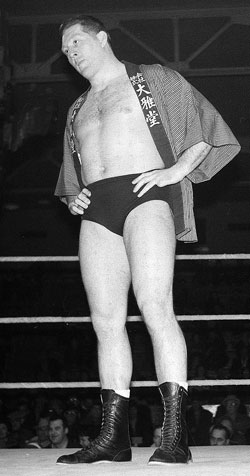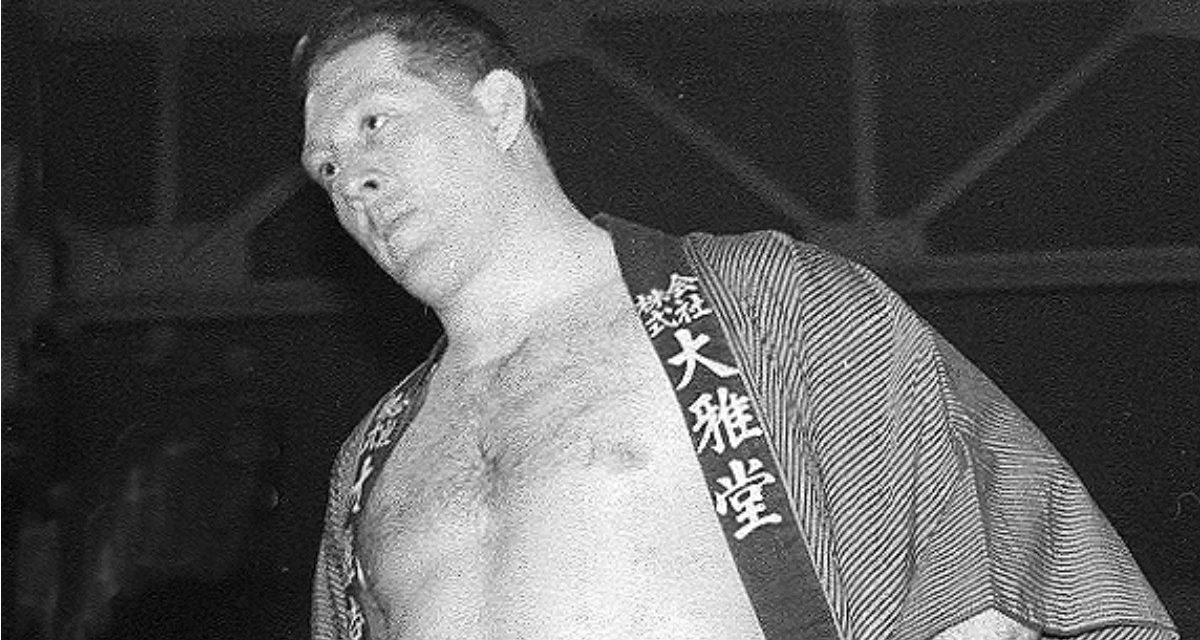His influence in wrestling will be felt for decades to come. His knowledge of submission style changed the landscape of Japanese wrestling and helped influence wrestlers like Tatsumi Fujinami and Hiro Matsuda.
Known as “Kamisama” in Japan, translated meant “God of Wrestling,” Karl Gotch died Saturday evening at the age of 82. Funeral arrangements are expected to be announced later this week.
Born as Karl Istaz in Hamburg, Germany, in 1924, Gotch started as an amateur wrestler at age nine, competing for Belgium in the 1948 Olympics. Shortly after, while still learning the industry himself, he began to train wrestlers in the art of amateur and submission wrestling.
He did most of his training at England’s Billy Riley Gym, which still taught the old catch-as-can style wrestling that was made famous by wrestlers like Farmer Burns.

Shot of Karl Gotch before a match in Calgary in 1965. Photo by Bob Leonard
He debuted in Europe under the name Karl Krauser. In the late 1950s, the 6-foot-2, 245-pound grappler would move to the United States to become a journeyman wrestler. He would adopt the name Karl Gotch after famous catch-as-can wrestler Frank Gotch, who dominated the wrestling world from 1908-1915, shortly after arriving in the U.S.
It was Columbus, Ohio promoter Al Haft who convinced Gotch to come to the U.S., and he arrived March 15, 1960 with wife Ella and daughter Janine. In the U.S., Gotch’s lack of showmanship hurt him, which he acknowledged in a February 1964 issue of Official Wrestling: “My only disappointment is the strong reliance on gimmicks. I am at a disadvantage, because I don’t dye my hair, I don’t wear elaborate costumes and I don’t have any funny names for the holds I use. My only gimmick is a knowledge of wrestling.”
Gotch also had an excellent knowledge of fitness. His neck and shoulder development was leagues ahead of his colleagues of the day. “Among the men, I have a reputation for being ‘gym crazy’…but I’d rather spend hours there than go into the ring in poor shape,” Gotch told Ring Wrestling in December 1968. “I’m no advocate of weight-lifting for wrestlers. Very early in my career, I met a Hindu wrestler who showed me exercises with a 3,000-year history of success — Hindu squats and tiger-bend push-ups, the most difficult kind. Today, in the gym, I would do about 300 squats and maybe 75 or 100 push-ups…about a third of what I started out doing, when I first learned them. then I’d finish up with front and back bridges and abdominal exercises — sit-ups and throwing the medicine ball.
His career in the United States became sour after a backstage fight with NWA World Champion Buddy Rogers in 1962 which would result in Gotch reportedly injuring Rogers. The incident left a black mark on Gotch, and he began looking for work in Japan.
The incident may forever remain a mystery in wrestling, and is chronicled in The Wrestling Hall of Fame: The Heels. Bill Miller, who was also involved in the incident claims only a few slaps took place, while Fred Blassie claims Miller and Gotch “beat the [expletive] out of [Rogers].”
Though it seems quaint today, Gotch’s finishing hold was simple. “His favorite is the Suplex, a dangerous hold that few other wrestlers have been able to master. The slightest miscalculation spells death,” hyped Inside Wrestling in its March 1972 issue. (Gotch also only had four fingers on one hand due to an accident when he was young.)
Gotch’s last U.S. stint came when he had a brief run with Rene Goulet as the WWWF Tag Team Champions. The duo defeated Crazy Luke Graham & Tarzan Tyler on December 6, 1971. They would lose the titles to King Curtis Iaukea & Mikel Scicluna on February 1, 1972.
“[Gotch] was a tough son-of-a-gun, a shooter,” Goulet told SLAM! Wrestling. “Just after we had the belts, everything was going good, Gotch had a chance to got to [Antonio] Inoki’s new promotion in Japan. They came all the way to New York and asked Karl if he wanted to become their booker. He agreed with it.”
Gotch main evented the first New Japan Wrestling show in 1972 against Antonio Inoki, the founder. His strong-style influence on Inoki and New Japan changed the landscape of wrestling in Japan. Inoki adopted Gotch’s style of submissions into international fame.
It was Gotch’s training and concepts that ultimately led to Inoki’s decision to wrestle Muhammad Ali in 1976 in a worked-shootfight that ultimately became a debacle.
During his time as booker and trainer for New Japan in the 1970s and 1980s, Gotch trained future stars such as Tatsumi Fujinami, Osamu Kido, Satoru Sayama, Barry Darsow and Yoshiaki Fujiwara. Gotch worked almost exclusively in Japan for the rest of his career, occasionally wrestling and training wrestlers near his Florida home. He also trained Hiro Matsuda, Kurt Rutkowsky (a.k.a. Kurt von Stroheim, and The Bavarian Boys — Harry Wizner and Rudy Jacobs — while based in Florida in the 1960s.
His wrestled his last match on January 1, 1982, when he defeated Yoshiaki Fujiwara in Tokyo. He wrestled the last decade of his career in mostly openers for New Japan.
Two of his trainees, Fujiwara and Akira Maeda, help start the original UWF Japan promotion in 1984. The new style of wrestling was more stiff and realistic than the style known in professional wrestling. The style was different than the Japanese fans were used to, and many believed the fights to be real. The popularity of the promotion and other promotions that followed it’s style (UWFi in the 1990s) led to promotions like New Japan and All Japan greatly changing the way they styled their matches.
Gotch was a member of Wrestling Observer’s first Hall of Fame class in 1996. He was a inductee of the Professional Wrestling Hall of Fame (PWHF) this past May.
Gotch’s style is still felt in wrestlers like Kendo KaShin and Yuji Nagata, the current IWGP World Champion as well as UFC and Pride fighters.
— with files from Greg Oliver
RELATED LINK

